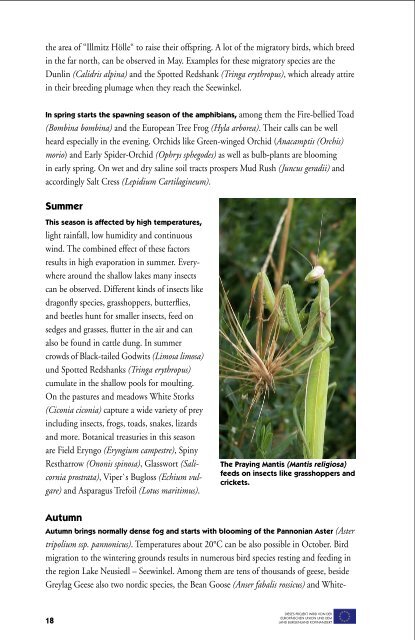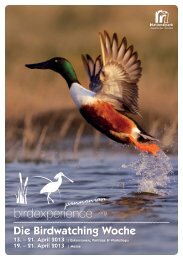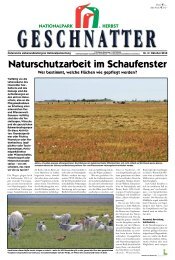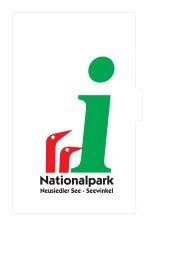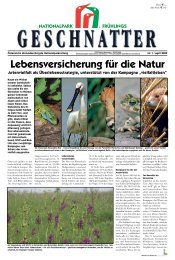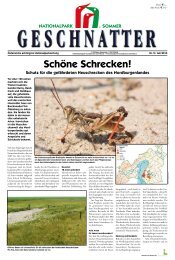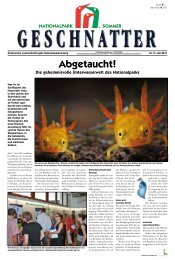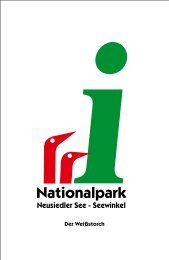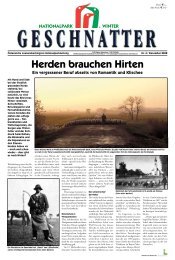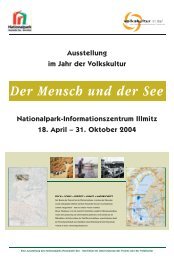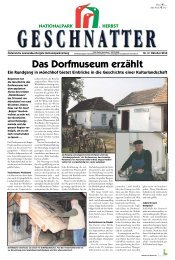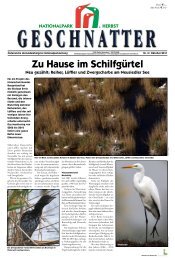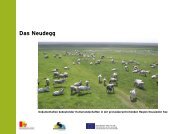Zicklacke - Nationalpark Neusiedler See Seewinkel
Zicklacke - Nationalpark Neusiedler See Seewinkel
Zicklacke - Nationalpark Neusiedler See Seewinkel
Erfolgreiche ePaper selbst erstellen
Machen Sie aus Ihren PDF Publikationen ein blätterbares Flipbook mit unserer einzigartigen Google optimierten e-Paper Software.
the area of “Illmitz Hölle“ to raise their offspring. A lot of the migratory birds, which breed<br />
in the far north, can be observed in May. Examples for these migratory species are the<br />
Dunlin (Calidris alpina) and the Spotted Redshank (Tringa erythropus), which already attire<br />
in their breeding plumage when they reach the <strong>See</strong>winkel.<br />
In spring starts the spawning season of the amphibians, among them the Fire-bellied Toad<br />
(Bombina bombina) and the European Tree Frog (Hyla arborea). Their calls can be well<br />
heard especially in the evening. Orchids like Green-winged Orchid (Anacamptis (Orchis)<br />
morio) and Early Spider-Orchid (Ophrys sphegodes) as well as bulb-plants are blooming<br />
in early spring. On wet and dry saline soil tracts prospers Mud Rush (Juncus geradii) and<br />
accordingly Salt Cress (Lepidium Cartilagineum).<br />
Summer<br />
This season is affected by high temperatures,<br />
light rainfall, low humidity and continuous<br />
wind. The combined effect of these factors<br />
results in high evaporation in summer. Everywhere<br />
around the shallow lakes many insects<br />
can be observed. Different kinds of insects like<br />
dragonfly species, grasshoppers, butterflies,<br />
and beetles hunt for smaller insects, feed on<br />
sedges and grasses, flutter in the air and can<br />
also be found in cattle dung. In summer<br />
crowds of Black-tailed Godwits (Limosa limosa)<br />
und Spotted Redshanks (Tringa erythropus)<br />
cumulate in the shallow pools for moulting.<br />
On the pastures and meadows White Storks<br />
(Ciconia ciconia) capture a wide variety of prey<br />
including insects, frogs, toads, snakes, lizards<br />
and more. Botanical treasuries in this season<br />
are Field Eryngo (Eryngium campestre), Spiny<br />
Restharrow (Ononis spinosa), Glasswort (Salicornia<br />
prostrata), Viper`s Bugloss (Echium vulgare)<br />
and Asparagus Trefoil (Lotus maritimus).<br />
The Praying Mantis (Mantis religiosa)<br />
feeds on insects like grasshoppers and<br />
crickets.<br />
Autumn<br />
Autumn brings normally dense fog and starts with blooming of the Pannonian Aster (Aster<br />
tripolium ssp. pannonicus). Temperatures about 20°C can be also possible in October. Bird<br />
migration to the wintering grounds results in numerous bird species resting and feeding in<br />
the region Lake Neusiedl – <strong>See</strong>winkel. Among them are tens of thousands of geese, beside<br />
Greylag Geese also two nordic species, the Bean Goose (Anser fabalis rossicus) and White-<br />
18


